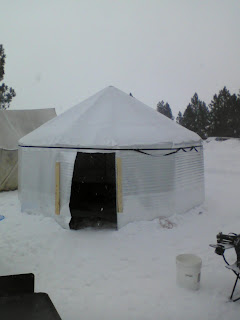On all three, I found that adding 1/2 conduit spacers and a tension band around the bottom helped to make the whole thing much sturdier. I used the area and radius formulas for dodecagon (12 sided polygon) from wikipedia to compute the lengths for the pieces. Wherever possible, I set up lengths that would allow me to make one cut to get two pieces - i.e. vertical side piece + horizontal piece = 10" for the steel stud frame.
All three frames are strong and stable. I can hang from the center on all of them - approx 200 lbs.
Steel stud frame
10 foot steel studs were purchased at Lowe's. The joints were cut out from two sheets of OSB glued together for thickness. The roof piece is 10 feet long. Horizontal piece is 55.5 inches and the vertical piece is 64.5 inches. Center height is 10 ft 6 in. Area is 225 square feet and the perimeter is 56 ft.
 |
| Labels for different parts |
2x4 frame
The joints were made from steel studs and riveted together. The roof piece is 8 feet long. Horizontal piece is 43.5 inches and the vertical piece is 5 ft. Center height is 9 ft. Area is 155 square feet and the perimeter is 45 ft. The foil faced insulation is Prodex, purchased from http://www.insulation4less.com/.
1/2 inch conduit
This is the design I'm focusing on at the moment. So, only two photos for now, but more to come. I'm focusing on this one because it's light, easy enough to put together for a one or two day campout, and should be quite inexpensive. The joints are made from 3/4 inch conduit welded together by a friend. The 1/2 inch conduit just slides into place. The roof pieces are 6 ft 10 in long. Horizontal pieces are 38 inches and the vertical pieces are 5 ft. Center height is 8.5 ft. Area is 107 square feet and the perimeter is 38 ft. I'm working on the cover now. When it's finished, I'll post the details and photos here.
 |
| conduit frame at left is quite a bit smaller than the steel stud frame |
If you'd like more specifics on any of these, leave a comment. I'm planning to do detailed plans for the conduit version soon.






















